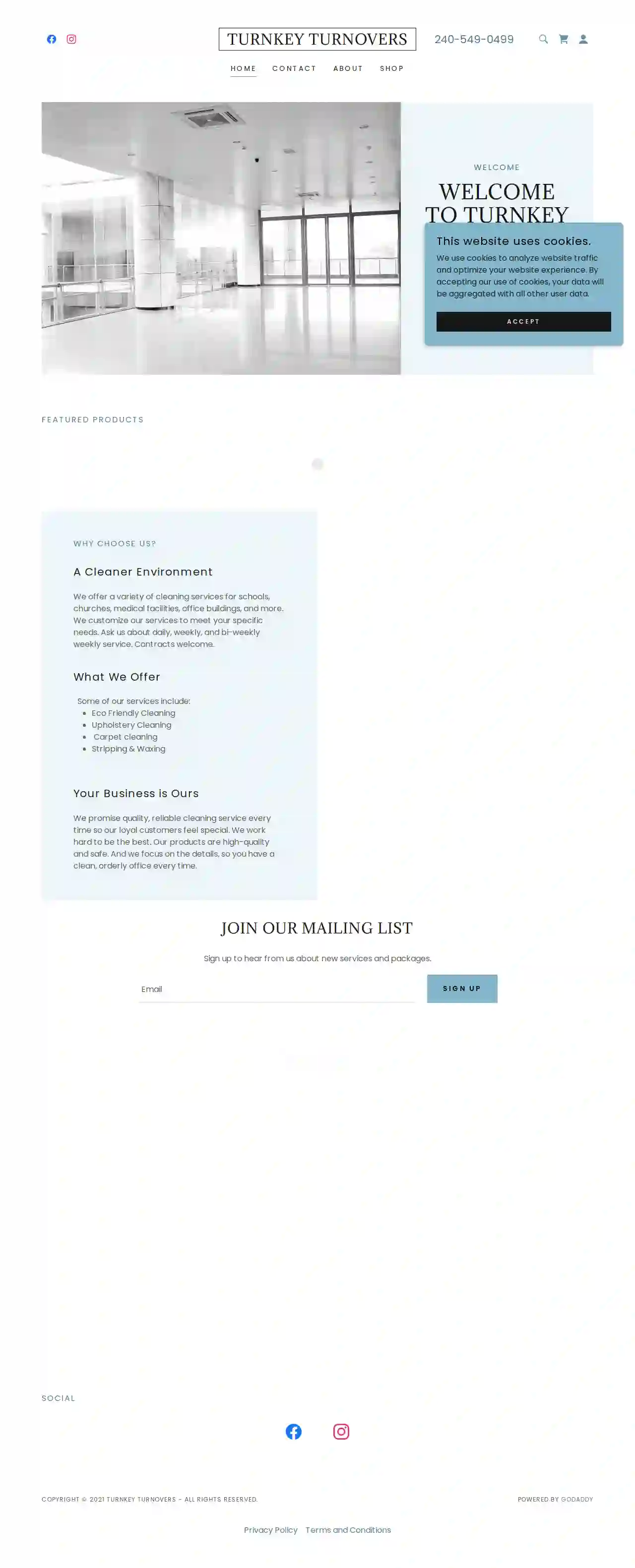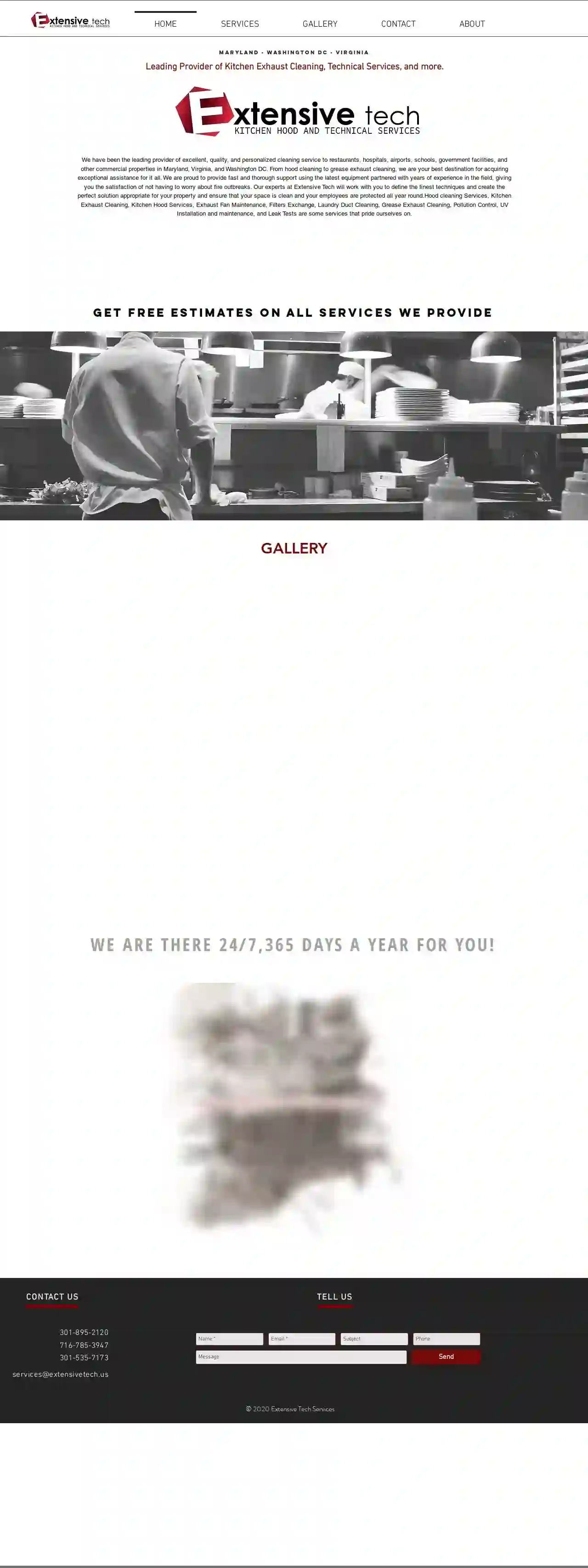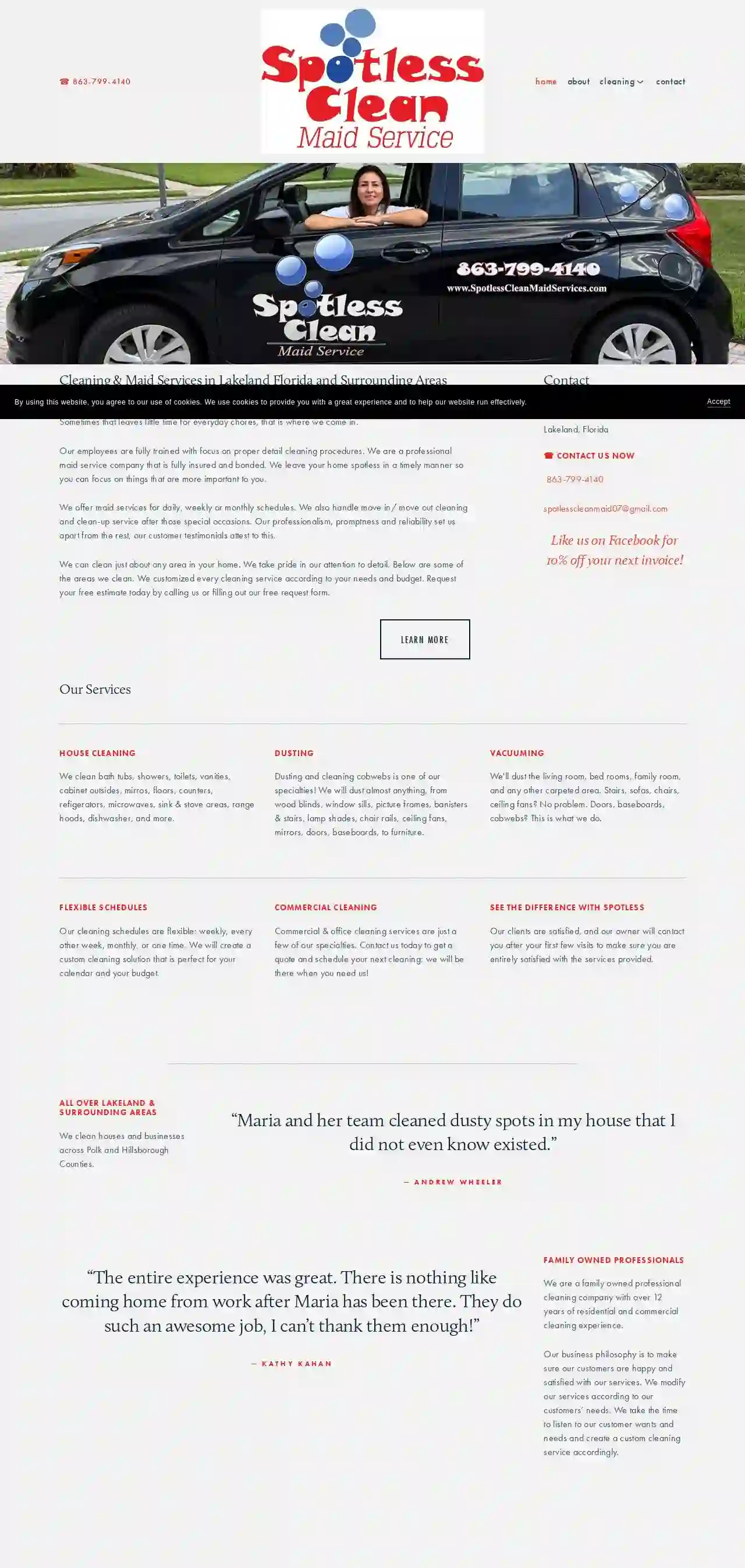Cleaning Services Fort Washington
Top Local Cleaners in Fort Washington
Get 3 FREE Home Cleaning quotes for your project today! Compare profiles, reviews, accreditations, portfolio, etc... and choose the best deal.
- Th
The Cleaning Machine, LLC
Frederick, USThe Cleaning Machine LLC is a professional cleaning services company dedicated to providing top-notch cleaning solutions for homes and businesses. With a strong commitment to customer satisfaction, our team of experienced cleaning professionals uses state-of-the-art equipment and eco-friendly products to ensure a sparkling clean environment. From one-time deep cleans to regular maintenance cleanings, we tailor our services to meet the unique needs of each client.
- Services
- Why Us?
- Gallery
Get Quote 
The Cleaning Authority - Frederick
4.7244 reviews304 S. Jefferson St., Frederick, 21701, USAt The Cleaning Authority - Frederick, we provide detailed house cleaning and sanitizing services for our valued clients across Frederick, Hagerstown, Clarksburg, Middletown, and New Market. Our team is committed to helping our clients with services that are environmentally responsible and effective. Best of all, they are affordable, which means that you can get the luxury of a maid service without breaking the bank. Our unique Detail-Clean Rotation System ensures that your home is cleaned to the highest standard. We use a careful system to deep clean each of your rooms on a rotating basis. This ensures your home is always thoroughly cleaned and sanitized, from the areas you use daily to that hard-to-clean grout!
- Services
- Why Us?
- Gallery
Get Quote
Maid Perfect Commercial Cleaning
59 reviewsBaltimore, US- Services
- Why Us?
- Gallery
Get Quote
Turnkey Turnovers ,LLC
52 reviewsFrederick, Maryland, PO BOX 3402, 21705, USTurnkey Turnovers is a professional cleaning service that offers a variety of cleaning solutions for schools, churches, medical facilities, office buildings, and more. We customize our services to meet your specific needs, including daily, weekly, and bi-weekly cleaning contracts. Our team is fully trained to handle any environment, ensuring all jobs are done properly and thoroughly for the safety of anyone entering the site. We prioritize health and safety, adhering to strict protocols and standards. Our services include eco-friendly cleaning, low moisture carpet cleaning, and we use products containing soap or detergent to limit the spread of COVID-19.
- Services
- Why Us?
- Gallery
Get Quote
Red Coats Inc
3.331 reviewsBaltimore, US- Services
- Why Us?
- Gallery
Get Quote
Extensive Tech Services
4.821 reviewsBaltimore, US- Services
- Why Us?
- Gallery
Get Quote
4th Street Laundromat
4.185 reviewsFrederick, US- Services
- Why Us?
- Gallery
Get Quote
Elite Commercial Cleaning L.L.C
57 reviewsBaltimore, US- Services
- Why Us?
- Gallery
Get Quote
Spotless Clean Maid Services
4.45 reviewsLakeland, Florida, 6749 S. Clifton Rd., 33813, USSpotless Clean Maid Service is a family-owned professional cleaning company located in Lakeland, Florida. With over 10 years of residential and commercial experience, they aim to provide customized cleaning services tailored to their customers' needs. Their business philosophy is to ensure customer satisfaction and happiness with their services. They offer flexible cleaning schedules including daily, weekly, or monthly, and also provide move in/move out cleaning and clean-up services for special occasions. Their team is fully trained with a focus on proper detail cleaning procedures, and they are fully insured and bonded.
- Services
- Why Us?
- Accreditations
- Our Team
- Testimonials
- Gallery
Get Quote
Pristine Cleaning Team
55 reviewsFrederick, US- Services
- Why Us?
- Gallery
Get Quote
Over 60,241+ Janitorial Services on our directory
Our janitorial services operate in Fort Washington & surroundings!
CleaningMatch has curated and vetted the Best Cleaning Contractors arround Fort Washington. Find a top & trustworthy business today.
Frequently Asked Questions About Cleaning Services
- Dishes: Load the dishwasher or wash dishes by hand.
- Sink: Clean the sink with a sponge or cloth and dish soap. Pay attention to the faucet and drain. You can also use a baking soda paste to remove stubborn stains.
- Countertops: Wipe down countertops with a disinfectant cleaner or all-purpose cleaner.
- Stovetop: Clean the stovetop with a degreaser or stovetop cleaner. Remove burner grates and wash them separately if needed.
- Oven: Clean the oven according to the manufacturer's instructions. You can use a self-cleaning function or a commercial oven cleaner.
- Microwave: Clean the microwave interior with a damp cloth or sponge. For stuck-on food, heat a bowl of water with lemon juice in the microwave for a few minutes to loosen debris.
- Refrigerator: Wipe down the refrigerator shelves and drawers with a damp cloth or sponge. Remove any expired food and clean spills promptly.
- Floors: Sweep or vacuum the floor, then mop with a floor cleaner suitable for your kitchen floor type.
- Trash: Empty the trash can and recycling bin.
- Regular dusting: Dust frequently using microfiber cloths or a duster. Pay attention to surfaces that attract dust, such as shelves, electronics, and furniture.
- Vacuuming: Vacuum carpets and rugs regularly using a vacuum cleaner with a HEPA filter to trap dust mites and allergens.
- Air Purifier: Consider using an air purifier to remove dust particles and allergens from the air.
- Reduce Clutter: Clutter provides more surfaces for dust to settle. Declutter regularly to minimize dust traps.
- Window Treatments: Wash or vacuum window treatments, such as curtains or blinds, regularly to remove dust buildup.
- Bedding: Wash bedding, including sheets, pillowcases, and blankets, weekly in hot water to remove dust mites.
- Doormats: Place doormats at entrances to trap dirt and dust from shoes before they enter your home.
- White Vinegar: A versatile cleaner that cuts through grease, removes stains, and deodorizes. Mix equal parts water and vinegar for a general-purpose cleaner.
- Baking Soda: A natural abrasive and deodorizer. Sprinkle baking soda on surfaces, let it sit, then scrub and rinse.
- Lemon Juice: Acts as a natural bleaching agent and disinfectant. Mix lemon juice with water for a cleaning solution or use it directly on stains.
- Castile Soap: A gentle and biodegradable soap made from plant oils. Mix a few drops of castile soap with water for a versatile cleaning solution.
- Essential Oils: Add a few drops of essential oils like tea tree oil or lavender oil to cleaning solutions for a natural fragrance and antibacterial properties.
- Cleaning: Removing dirt, dust, and debris from surfaces using soap or detergent and water. It improves the appearance and removes visible contaminants.
- Sanitizing: Reducing the number of bacteria on surfaces to a safe level. It uses chemical disinfectants or heat to kill or inactivate bacteria.
- Disinfecting: Killing or inactivating most disease-causing microorganisms on surfaces. It uses stronger chemical disinfectants than sanitizing and targets a wider range of pathogens.
What is the most efficient way to clean a kitchen?
Regularly cleaning your kitchen helps maintain a hygienic and organized space for cooking and dining.
How do I prevent dust from accumulating in my home?
By implementing these preventive measures, you can significantly reduce dust accumulation and maintain a cleaner and healthier home.
What are some eco-friendly cleaning solutions?
Remember to test these solutions on a small, inconspicuous area first to ensure they don't damage delicate surfaces.
What is the difference between cleaning, sanitizing, and disinfecting?
Cleaning is usually the first step, followed by sanitizing or disinfecting depending on the level of hygiene required.
What is the most efficient way to clean a kitchen?
- Dishes: Load the dishwasher or wash dishes by hand.
- Sink: Clean the sink with a sponge or cloth and dish soap. Pay attention to the faucet and drain. You can also use a baking soda paste to remove stubborn stains.
- Countertops: Wipe down countertops with a disinfectant cleaner or all-purpose cleaner.
- Stovetop: Clean the stovetop with a degreaser or stovetop cleaner. Remove burner grates and wash them separately if needed.
- Oven: Clean the oven according to the manufacturer's instructions. You can use a self-cleaning function or a commercial oven cleaner.
- Microwave: Clean the microwave interior with a damp cloth or sponge. For stuck-on food, heat a bowl of water with lemon juice in the microwave for a few minutes to loosen debris.
- Refrigerator: Wipe down the refrigerator shelves and drawers with a damp cloth or sponge. Remove any expired food and clean spills promptly.
- Floors: Sweep or vacuum the floor, then mop with a floor cleaner suitable for your kitchen floor type.
- Trash: Empty the trash can and recycling bin.
Regularly cleaning your kitchen helps maintain a hygienic and organized space for cooking and dining.
How do I prevent dust from accumulating in my home?
- Regular dusting: Dust frequently using microfiber cloths or a duster. Pay attention to surfaces that attract dust, such as shelves, electronics, and furniture.
- Vacuuming: Vacuum carpets and rugs regularly using a vacuum cleaner with a HEPA filter to trap dust mites and allergens.
- Air Purifier: Consider using an air purifier to remove dust particles and allergens from the air.
- Reduce Clutter: Clutter provides more surfaces for dust to settle. Declutter regularly to minimize dust traps.
- Window Treatments: Wash or vacuum window treatments, such as curtains or blinds, regularly to remove dust buildup.
- Bedding: Wash bedding, including sheets, pillowcases, and blankets, weekly in hot water to remove dust mites.
- Doormats: Place doormats at entrances to trap dirt and dust from shoes before they enter your home.
By implementing these preventive measures, you can significantly reduce dust accumulation and maintain a cleaner and healthier home.
What are some eco-friendly cleaning solutions?
- White Vinegar: A versatile cleaner that cuts through grease, removes stains, and deodorizes. Mix equal parts water and vinegar for a general-purpose cleaner.
- Baking Soda: A natural abrasive and deodorizer. Sprinkle baking soda on surfaces, let it sit, then scrub and rinse.
- Lemon Juice: Acts as a natural bleaching agent and disinfectant. Mix lemon juice with water for a cleaning solution or use it directly on stains.
- Castile Soap: A gentle and biodegradable soap made from plant oils. Mix a few drops of castile soap with water for a versatile cleaning solution.
- Essential Oils: Add a few drops of essential oils like tea tree oil or lavender oil to cleaning solutions for a natural fragrance and antibacterial properties.
Remember to test these solutions on a small, inconspicuous area first to ensure they don't damage delicate surfaces.
What is the difference between cleaning, sanitizing, and disinfecting?
- Cleaning: Removing dirt, dust, and debris from surfaces using soap or detergent and water. It improves the appearance and removes visible contaminants.
- Sanitizing: Reducing the number of bacteria on surfaces to a safe level. It uses chemical disinfectants or heat to kill or inactivate bacteria.
- Disinfecting: Killing or inactivating most disease-causing microorganisms on surfaces. It uses stronger chemical disinfectants than sanitizing and targets a wider range of pathogens.
Cleaning is usually the first step, followed by sanitizing or disinfecting depending on the level of hygiene required.